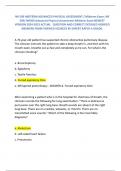Exam (elaborations)
NR 509 MIDTERM ADVANCED PHYSICAL ASSESSMENT / Midterm Exam: NR 509/ NR509 Advanced Physical Assessment Midterm Exam NEWEST VERSION ACTUAL QUESTION AND CORRECT DETAILED VERIFIED ANSWERS FROM VERIFIED SOURCES BY EXPERT RATED A GRADE.
- Course
- Institution
NR 509 MIDTERM ADVANCED PHYSICAL ASSESSMENT / Midterm Exam: NR 509/ NR509 Advanced Physical Assessment Midterm Exam NEWEST VERSION ACTUAL QUESTION AND CORRECT DETAILED VERIFIED ANSWERS FROM VERIFIED SOURCES BY EXPERT RATED A GRADE.
[Show more]



